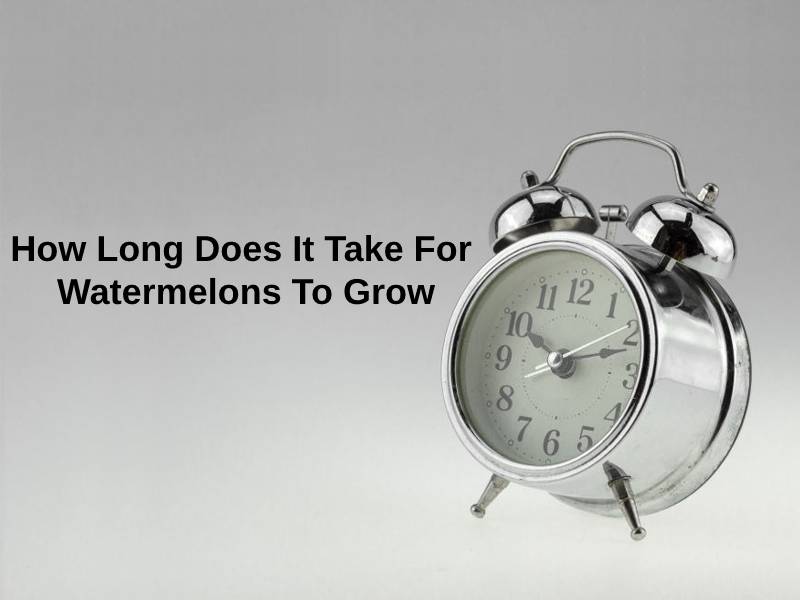Exact Answer: 70 – 90 Days
Watermelons, also known as Citrullus lanatus, are big and deliciously sweet fruit. They come in different varieties all having different periods of maturity. It is known not only for being sweet and juicy, but it is also incredibly refreshing as compared to other fruits.
The first recorded evidence of a watermelon crop occurred more than 5,000 years ago in Egypt. One just needs a seed, well-drained soil, water, and sun for raising delicious, juiciest, and sweetest watermelons. The ideal date to plant watermelons varies according to the climate of the region. To produce the sugar necessary for the sweet fruit, the melons need hot weather.
Seedlings should not be transplanted until after the last average frost date in the spring when the soil temperature at a depth of four inches is at least 60 degrees Fahrenheit. Watermelons cannot tolerate frost and should not be planted where the night temperature dips below 50 degrees Fahrenheit. Lower temperature causes the fruit to lose its flavor. Melons grow best when the soil temperature is 75 degrees or above.

How Long Does It Take For Watermelons To Grow?
| Varieties | Duration |
| Golden Crown, Sugar Baby, Yellow Baby | 70 – 75 days |
| Charleston Gray, Sunny’s Pride, Sangria | 80 – 85 days |
| Crimson Trio, Honey Heart, Nova, Tiffany, Queen of Hearts | 85 days or more |
Generally, watermelons reach the harvest 70 to 85 days after sowing. Smaller varieties of watermelons get ready before the large one, but not always. Some varieties can even take 100 days or more to produce ripe fruit. Thus, a good average for how long watermelons take to grow is 90 days or 3 months after the watermelon seeds have sprouted.
Early-harvesting watermelons include melons which are about six to ten pounds in weight. As the watermelons near their maturity, some varieties develop a circular crack around the stem. After watermelon plants start to flower, they should produce full-sized harvestable watermelons in 6 to 7 weeks. On watermelon plants, the male flowers show up a week or two before the female flowers.
If one side of the watermelon was resting on the ground, it goes from being white to yellow. A dull sound is produced when one thuds a ripe melon. Watermelons are 92% water and that is the reason why they taste so refreshing on a hot summer day. The watermelon plants require full sun locations. Thus, they need to get direct sunlight for 8 – 10 hours a day or more.
Why Does It Take So Long For Watermelons To Grow?
The first step in growing juicy and delicious watermelons is to choose which variety to grow. There are mainly three kinds of variety: 1. Early season, 2. Main season, and 3. Seedless watermelons. An early-season watermelon is sometimes called an icebox melon because it grows to a petite size that can easily fit inside the refrigerator shelf. This variety takes the shortest time to mature i.e. about 70 – 75 days.
Other varieties take anywhere from 80 to 90 days or sometimes, even more, to ripen as they are larger. Seedless watermelons grow like the other types of watermelon, but since there are no seeds inside them, they are sweeter.
Watermelons need soil that is well-drained and sandy. They also require a pH level between 6 to 6.5 of the soil. Typically, watermelon plants need 1 – 2 inches of water per week soo that the soil stays moist but not wet. Within 5 to 10 days, the seedlings of the watermelon plant should germinate.
Once watermelon vines begin producing blossoms, the key to fruit set is pollination by bees. One should avoid spraying too much for flying insects as chemicals can kill certain beneficial bugs which the watermelon plant might need.
Conclusion
Growing a watermelon plant is not a herculean task. One should take enough care of the tender plants to ensure the best possible harvest. Watermelons take about 70 to 90 to reach ripeness depending on the variety and growing season.
Anyone can do grow watermelons, provided that the plants are kept happy throughout all seasons by providing them with the right amount of water, protecting them from diseases and pests, and adding extra nutrients to the soil as and when needed.